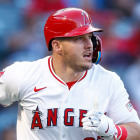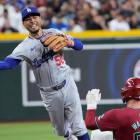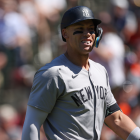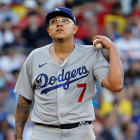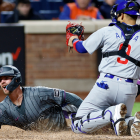The 2019-20 offseason is still young. Not so young that we're still waiting for a free agent to change teams -- Will Smith signed a three-year deal with the Braves last week -- but young enough that not a whole lot has happened around the league.
This free-agent class is one of the best we've seen in recent years. Three superstars are available in Gerrit Cole, Anthony Rendon, and Stephen Strasburg, plus other quality players like Madison Bumgarner and Hyun-Jin Ryu are on the market as well. This free-agent class could've been even better had several players not opted for long-term security earlier in their careers, however.
These days many players sign long-term contract extensions early in their careers, pushing back their free agency. They trade their maximum earning potential (through arbitration and free agency) for financial security early in their careers. I don't blame them one bit. I'd do the same thing. It does mean these top youngsters aren't hitting free agency when expected though.
It takes six full years of service time to quality for free agency, but, given the way teams manipulate service time these days, it often takes closer to seven years. George Springer, for example, would have been a free agent this offseason had the Astros carried him on their Opening Day roster in 2014. Instead, they kept him down until mid April, and that was enough to push his free agency back.
There are seven players in MLB who reached six years of service time in 2019, but did not become free agents this offseason because they signed early career extensions. Because we like ranking things, here is a wholly subjective ranking of those seven players, who would have undoubtedly spiced up the offseason had they not signed extensions.
Even with the knee fracture that ended his season on Sept. 10, Brewers slugger Christian Yelich would've been the No. 1 free agent this offseason. Ahead of Cole, ahead of Rendon, ahead of everyone. Yelich will turn only 28 next month and he just put together back-to-back MVP caliber seasons. His ranks the last two years (min. 1,000 plate appearances for rate stats):
- Batting average: .327 (1st in MLB)
- On-base percentage: .415 (2nd)
- Slugging percentage: .631 (2nd)
- Home runs: 80 (3rd)
- WAR: 14.7 (5th)
Yelich is a top-five player in baseball, he is still two years away from his 30th birthday, and he is the type of player who fits any team because he can play any outfield position. It would be very easy to make room for him on your roster. The opportunities to acquire a prime-aged superstar for nothing but cash are few and far between. The Yelich bidding war would've been fierce.
The Marlins wisely signed Yelich to his extension prior to the 2015 season. It looked like a good deal at the time and is an absolute steal now. At the time, it appeared the contract would make Yelich affordable enough for Miami to keep him and build around him. That is not how it played out and the Brewers are now reaping the rewards of one of the most team-friendly contracts in the game.
What would he get this offseason? Yelich is, pretty clearly, a $300-million player. Bryce Harper was two years younger than Yelich when he became a free agent and Manny Machado was 18 months younger, but Yelich was more productive in the years heading into free agency, and there's less baggage here. Machado in particular created some headaches last postseason. Ten years and $350 million would have been a reasonable expectation for Yelich.
It is no secret teams are not scared away by performance-enhancing drug suspensions. Francisco Cervelli, Nelson Cruz, and Jorge Polanco are among the players who signed lucrative multi-year contracts after serving a performance-enhancing drug suspension in recent years. Pirates center fielder Starling Marte would have been the latest to do so.
Marte, 31, served his suspension back in 2017. He has since put together very good 2018 and 2019 seasons, though his center field defense is slipping a bit, which is not too surprising. Center field is a young man's position. Marte remains an above-average hitter with elite baserunning and good enough defense to remain in center for the foreseeable future. He's mighty valuable.
The Pirates have a long history of locking up their best young players -- they did it with Jason Kendall way back in the day and have continued it with Marte, Andrew McCutchen, Gregory Polanco, and others -- and they signed Marte following his breakout 2014 season. It still qualifies as a team-friendly deal, though that 2014 season has proven to be Marte's career year.
What would he get this offseason? Dexter Fowler signed a five-year, $82.5 million contract at Marte's age three years ago. Lorenzo Cain was one year older than Marte when he became a free agent, and he received five years and $80 million. Five years and $80 million or so is market rate for a veteran center fielder in his early 30s.
It has now been four years since current Indians closer Brad Hand emerged as a dominant high-leverage reliever. He's great against righties, he's great against lefties, and he's struck out more than one-third of the batters he faced the last two years. It can be easy to typecast good left-handed relievers into a left-on-left role, but Hand is so much more than that. He's an elite reliever at a time when elite relievers have never been more valuable. The Padres signed him after back-to-back great seasons.
What would he get this offseason? Hand turns only 30 in March, and while I think he would fall short of the $17 million per year Aroldis Chapman, Wade Davis, and Kenley Jansen received on their recent contracts, I think he's easily an eight-figure reliever. The Yankees gave Zack Britton three years and $39 million last offseason and he was a year older than Hand is now. I think Hand, as the best reliever in this free agent class, would've been able to secure four years and upward of $15 million per year.
It took some time, but Cardinals second baseman Kolten Wong has established himself as a bona fide two-way threat. He is no longer a defense-first infielder. Wong pairs very good on-base percentages with sneaky power and Gold Glove caliber defense. He turned only 29 last month too, so he should still have several years of peak production ahead of him. Wong has quietly put up 8.2 WAR the last two seasons. Only a handful of middle infielders can make that claim. St. Louis gave Wong the contract after his first full MLB season, so they bet on him, and it has paid off.
What would he get this offseason? Unfortunately for Wong, defense still doesn't pay all that great. It's valuable, don't get me wrong, but the clearest path to a big payday is big offense. Marwin Gonzalez, DJ LeMahieu, Jed Lowrie, and Daniel Murphy all received two-year deals in the $10.5 million to $12 million range last offseason. Wong is at least a full year younger now than those guys were then, so I suspect he'd get an extra year (or two). Three years and $12 million per season is a reasonable estimate.
It wasn't too long ago that Cardinals right-hander Carlos Martinez looked like a budding ace. Injuries have limited him to 18 starts and 47 relief appearances the last two seasons, though he turned only 28 in September. It's not crazy to think the best is still to come with Martinez. Given the general injury risk associated with being a pitcher, I bet he's thankful he locked in that payday a few years ago and doesn't have to stress about his contract status after all the injuries the last two years.
What would he get this offseason? It's hard to say. Martinez did make 48 relief appearances this past season and he pitched like an elite closer, but I think it's still too soon to pull the plug on him as a starter. Martinez would've been a good candidate for a creative contract. Something like, say, three years and $30 million in guaranteed money, with incentives tied to starts and innings pitched. That way he gets paid appropriately should he successfully transition back into the rotation.
What a fall it has been for Chris Archer. From 2013-15, the right-hander strung together three consecutive ace-like seasons. He's performed worse every season since -- Archer's ERA has gone from 4.02 to 4.07 to 4.31 to 5.19 the last four years -- and is firmly in reclamation project territory now. Also, Archer is already 31. Who knew? I would've guessed he's 28 or 29, but no, he turned 31 in September. A four-year downward trend in performance and being on the wrong side of 30 is a tough combination. Archer signed his contract prior to his first full MLB season, when he had less than one year of service time.
What would he get this offseason? The Angels gave Matt Harvey what amounted to a one-year "prove yourself" contract worth $11 million last offseason. That would probably have been Archer's upside this offseason. I have no doubt several teams would believe they can fix him and get him back to what he was a few years ago, but I don't think anyone would believe it enough to hand out a multi-year deal worth $8 million or more per season.
Even though he turns 29 next month and has over 3,000 big league plate appearances to his credit, it still feels like we're waiting to find out what kind of player Wil Myers can be. The Padres' sometimes first baseman, sometimes outfielder has managed 500 plate appearances in back-to-back seasons only once in his career, and he consistently leaves you wanting more with the bat. Also, what position does Myers play? He should probably be a first baseman going forward, but I'm not 100 percent convinced of that. San Diego signed Myers after what looked like a breakout 2016 season.
What would he get this offseason? Because he is on the right side of 30 and you can talk yourself into that breakout year being right around the corner, I think Myers would still be a candidate for a multi-year contract. Two years and $20 million total, something along those lines. From an American League team, of course.
Impending free agents who signed contract extensions earlier this year were excluded from consideration for this piece. Six players signed extensions earlier this year rather than roll the dice in free agency. The six players listed in order of total guarantee:
- 3B Nolan Arenado, Rockies: 8 years, $260 million.
- SS Xander Bogaerts, Red Sox: 6 years, $120 million plus one club option year.
- OF Aaron Hicks, Yankees: 7 years, $70 million plus one club option year.
- DH Khris Davis, Athletics: 2 years, $33.75 million.
- RHP Sonny Gray, Reds: 3 years, $30.5 million plus one club option year.
- RHP Ryan Pressly, Astros: 2 years, $17.5 million plus one club option year.
Historically, players who sign extensions one year (or less) prior to free agency get free-agent dollars. There are no discounts and that is reflected in those contracts.
For this post, the intention was to look at players who signed long-term extensions years ago, much earlier in the careers, that are now preventing them from hitting the open market after reaching six years of service time. I doubt any of those seven players are complaining -- well, maybe Yelich is, but who knows whether he even becomes the player he is today without the peace of mind he got from his contract -- but it does take a little bite out of free agency.




























